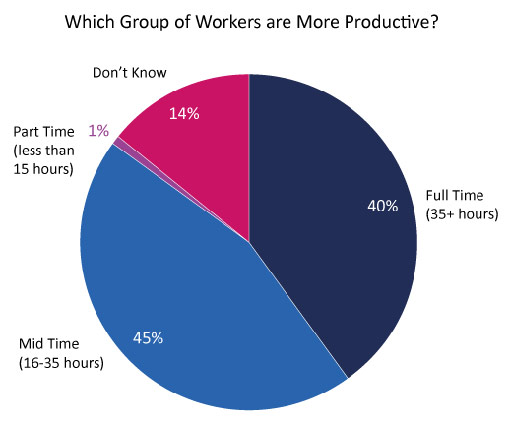In 2019 I had the opportunity to reduce my hours, starting my first role on a 4-day week.
Today I can tell you for sure: the benefits are huge, and in this article I want to explore how we can make it viable for more people.
Is It Worth It?
On a personal level, I have more time with my family and for myself. I feel more relaxed overall and it’s easier to recover from the inevitable hard days at work. At work, I am as productive as I was before but the quality of my work has improved dramatically: more thought-through, scalable and resilient.
For instance, I have to create decision-making processes that don’t require me in person, because 20% of the time you need a decision, I won’t be there!
That means more development and empowerment for my team and greater authority to forums and working groups to make balanced decisions and take action when supported by common agreement.
After more than two years with a 3-day weekend, I don’t ever want to give it up, but it’s more than that. For our mental health, for our job satisfaction, for our organization’s success – I think everyone should do the same.
You don’t have to listen to me, though – a 4-day week has long been studied by governments, including the UK’s Flexible Working Task Force.
With more progressive countries around the world already making daring moves in this direction, it’s important for our economy’s future that our companies plan how they might make this work before it’s forced in through legislation.
Are 4-Day Workers More Productive?
It is very hard to find any published research on which type of workers are more productive.
Call Centre Helper recently ran a poll on its LinkedIn group that tends to support the 4-day worker, with 45% of respondents sharing the view that working between 16 and 35 hours per week provides the ideal balance for improved productivity.

Source: Call Centre Helper Poll (conducted on LinkedIn) Sample size – 147 Date: November 2021
Why Hasn’t 4-Day Working Happened Already?
Concerns have been flagged for some time. Esther Lombardi outlined 4 key concerns in 2014 and they are still broadly valid today. The maths is against us too – to offset a 20% reduction in work hours (1 day out of 5) you need to improve the value of your output by 25% (1 extra day’s output out of 4). A tall order by any standard.
Information is also… incomplete. Much of the research available on 4-day weeks relates to roles like mine and, from what we are told, in leadership and creative roles (where you have the scope to choose how you achieve your objectives) working with a clearer head is a winner.
The 4-day week will likely find little resistance there. But to institutionalize it we need to make this applicable to more transactional roles as well, where physical presence/availability is a core requirement.
Industries like retail, healthcare, hospitality, logistics and security have a much harder task to demonstrate that a 4-day week can be as effective as a 5-day one.
Industries like retail, healthcare, hospitality, logistics and security have a much harder task to demonstrate that a 4-day week can be as effective as a 5-day one. A 2-year pilot of a 6-hour working day for 70 nurses cost the Swedish government £1.2 million – not something many private companies would do.
The same challenge exists in contact centres where we need to be “online” to answer customer queries whenever the customer decides to contact us.
Hours worked are so important that we often don’t know how many people we employ unless we speak in FTE (Full-Time Equivalent, which is a unit of time, generally around 40 hours per week).
Even in my own reports, I’m only 0.8 of a person! Switching everyone from 5 to 4 days would seem catastrophic in this environment, but I think there are ways of making it work even here. Let me walk you through the numbers.
How Much Do We Really Work?
Firstly, it’s important to remind ourselves that we are not as productive as we think. The example below shows numbers I would associate with an already efficient environment.
Even so, by the time we have taken out annual leave, sickness, meetings, training, breaks and idle time, a 40-hour week is reduced to 22.4 hours of productive working time. Only 56% of the original paid hours.
| Metric | Description | 5-day week | 4-day week | Loss of hours |
|---|---|---|---|---|
| Full-Time Hours | Paid hours per week | 40 | 32 | 8 |
| Annual Leave | AL allowance as % of your working year | 10% | 10% | |
| Sickness | Average sickness per person as % of working year | 4% | 4% | |
| Other Shrinkage | Meetings, training, coaching, breaks, etc. | 16% | 16% | |
| Online Hours | Hours left after all shrinkage is removed | 28 | 22.4 | 5.6 |
| Occupancy | % of online hours spent working vs. waiting for next call | 80% | 80% | |
| Productive Hours | Online hours * occupancy | 22.4 | 17.92 | 4.48 |
We therefore have to remember that we aren’t losing 8 hours of work, just 4.5 – our problem is already nearly halved.
With these numbers we can express the 4-day-week problem through two questions:
- Can we get more than 17.9 hours of work out of 32 paid?
- Can we do the work that we do in 22.4 hours in just 17.9 hours?
It’s important to differentiate the two because the solutions are wildly different. The first requires effort to increase capacity, the second is all about increasing efficiency and the value of the work we do.
I believe both approaches will be needed. The 25% productivity gap can be solved partly by an improved ratio of productive to paid hours, and partly by an improved effectiveness/value of our work.
The Pros and Cons of 4-Day-working
Pros
- Higher individual productivity
- Employees tend to be happier and more relaxed
- Contact volumes are typically higher Monday to Thursday (allowing some people to take Fridays off could help match demand with staffing levels)
- Staff could be less likely to leave as they have a work/life balance
- Reduced need for office space
Cons
- More staff members may be needed if productivity is not increased
- May create problems with scheduling
- Belief that full-time employees are more invested in the company
- Many people want to work full-time
- Difficulty arranging meetings and training sessions
- Higher attrition from part-time employees
How to Increase Capacity?
The first part of the calculation looks at shrinkage, and our aim should be to reduce those percentages as much as possible.
Annual leave will obviously not change, and while there is a lot of talk about the benefits of reduced hours for well-being and work absence, I haven’t seen any conclusive data and am therefore cautiously assuming that sickness will remain unchanged.
We can control other shrinkages to an extent but we have to be really cautious because some of these could increase.
Monthly 1-to-1s are pretty standard in our industry and they will be needed (and last just as long) regardless of your working hours.
Team meetings, training, coaching session will also follow this pattern, and I estimate that in total these will take our shrinkage to 17.2%.
In Microsoft Japan’s 4-day-week trial, they capped all meetings to 30 minutes and other companies have been rumoured to have banned private appointments (e.g. dentist) during the 4 work days.
Fully training and briefing frontline staff is key to providing customers with accurate support, while their feedback and insight are indispensable for continuous improvement.
Options like those might be appropriate to your organization but can also be risky. Fully training and briefing frontline staff is key to providing customers with accurate support, while their feedback and insight are indispensable for continuous improvement. In the numbers I’ll share later, I have therefore increased shrinkage rather than reducing it, but hopefully you can do better.
Occupancy is where the real game is at. Get your Erlang-C calculator, hire someone who can use it, and get creative about how to improve the flow of work to reduce idle time. I’ll tell you a secret – it’s all about scale!
The bigger the teams, the higher the occupancy you can work at while still providing a responsive service to customers. The Post Office sussed that out a while ago – that’s why you don’t have a small queue for every desk any more but one big queue served by all desks.
In call centres it means that if we can merge teams into larger units, we can provide the same service at higher occupancies (or better service for the same cost if you are that way inclined).
Scale doesn’t stay still, though. You might have 100 people on Monday at 11am but on Sunday at 6pm your centre might be down to 2 or 3 people. Occupancy will therefore suffer the more stretched out your operation is.
Some companies might find it appropriate to reduce opening hours and focus on the time where the majority of customers need them. Every company is different so you will need to assess if you are staying open on a Sunday because of true demand or as a marketing gimmick and make recommendations accordingly.
Whatever your approach, make sure you understand what your shrinkage and occupancy are today and engage people and tools that can help you improve them. Most importantly, take a mathematical approach to organizational design to build departments where work flows efficiently.
How to Improve Efficiency?
That’s simple – do it better, faster!
Shame that “simple” is not the same as “easy”.
Thankfully, there are lots of tools out there to make this easier, because I really believe that this is where most of the 4-day-week productivity gap needs to be solved.
We can’t be 125% productive so we have no choice but to do less work in our productive time compared to now. For me personally, this meant not getting involved in things that others in my team were already doing, spending more time setting things up correctly and less double-checking everything.
For agents in a contact centre, this means two things: Reduce your handling time and avoid the need for calls.
There are lots of ways to help speed up a call:
- Simplify your products and customer journeys (which is just good sense anyway)
- Introduce robotic process automation (RPA) to take on any post-call admin
- Improve training to reduce time searching for answers
- Improve speed to competency (it can take months for new people to become proficient)
- Reduce attrition (every leaver that has to be replaced adds to your learning curve)
- Improve the escalation process or, better, empower frontline staff to deal with them
By the end of that list you would hope AHT has been reduced by at least 10%.
Equally, there are lots of things that you can do to reduce the volume of calls from customers.
- Simplify your products and customer journeys (still good sense)
- Be really careful with outbound calls. No one likes them, and if a customer doesn’t answer after three attempts, take the hint (in my experience, conversion rates drop after that anyway).
- Use calls as training – you can save 10 seconds now, or take an extra minute to save the customer a call every month by walking them through the app/website. Do the latter.
- First time resolution. In most places I’ve worked, repeat callers (same phone number, same month) accounted for nearly 30% of the volume. Pure failure demand.
- Provide answers in your IVR (the most advanced IVR I work with answered 40% of customer queries)
You will often hear grand proposals of how new tech will stop all calls and everyone will be happier – I don’t buy it any more, but we should aim to at least avoid a quarter of the repeat calls we currently get.
What Does It Add Up To?
A lot of work.
Extending the scenario I presented earlier, we can absorb the full productivity gap and the increased shrinkage in just three moves:
- Increase occupancy by 5% (from 80% to 85%)
- Reduce handling time by 10% (from 300 seconds to 270)
- Reduce repeat calls by 25% (from 81 to 61 per person per week)
| Metric | Description | 5-day week | 4-day week | Change |
|---|---|---|---|---|
| Full Time Hours | Paid hours per week | 40 | 32 | -8 |
| Annual Leave | AL allowance as % of your working year | 10% | 10% | |
| Sickness | Average sickness per person as % of working year | 4% | 4% | |
| Other Shrinkage | Meetings, training, coaching, breaks etc. | 16% | 17.2% | 1.2% |
| Online Hours | Hours left after all shrinkage is removed | 28 | 22 | -6 |
| Occupancy | % of online hours spent working vs waiting for next call | 80% | 85% | 5% |
| Productive Hours | Online hours * occupancy | 22.4 | 18.7 | -4 |
| AHT | Average length of call in seconds | 300 | 270 | -30 |
| Base Call Demand | Customer enquiries we need to answer | 188 | 188 | |
| Repeat Calls (30%) | Calls from customer that had to call back a second time or more | 81 | 61 | -20 |
| Total Call Demand | Total calls we have to answer | 269 | 249 | -20 |
| Total Call Capacity | How many calls a person can answer | 269 | 250 | -19 |
In smaller organizations you might find that starting occupancy is much lower and has a higher growth potential. In others digitalization can further reduce calls to the extent where you don’t need to worry about AHT.
In all cases, though, this adds up to a deliberate and targeted effort to move every available lever in order to make a 4-day week a reality. It will not happen by itself.
What About the Employer?
Most of what we have discussed so far is about employees working harder and smarter and none of the benefits and efficiencies listed are directly born from the 4-day-week.
In fact, I am saying that employers should rethink their structures and processes to offset the cost of a 4-day week. Obviously, this begs the question “why don’t we do these things on a 5-day week?”
The 4-day week may not directly give efficiency gains but it creates an environment where working more productively is sustainable without causing headset-induced brain damage.
The answer, at least for call centres, is “I don’t think you can.”
Call centre agents are some of the most tightly supervised and micromanaged people around. Employers can track every button that’s pressed and record (for training and quality purposes) every word you say or write. All while being the lowest-paid employees in most companies.
Working 270-second calls at 85% occupancy means that on average you have 47 seconds between one call ending and the next starting.
In that call, you have to greet the customer, understand their issue, understand their mood, adjust to their mood to establish a relationship, resolve their problem, train them to self-serve in future and leave them, 270 seconds later, feeling happy and with a stronger bond with your brand than before they called you.
You might even have referred them for a second product if you know what you’re doing. You then have enough time for a high-five and a sip of water before the phone rings again.
We want a lot from our people – and I believe everyone enjoys doing a great job. Working at that pace is possible and highly effective with the right support and breaks.
The 4-day week may not directly give efficiency gains but it creates an environment where working more productively is sustainable without causing headset-induced brain damage.
What employers therefore need to do is commit. Make a statement that this is what you are aiming for and set clear targets for what efficiency you need to reach to make the change economically viable.
Is There a Bigger Picture?
Today I looked purely within the contact centre’s own walls, as a mathematical rather than commercial exercise. In reality we need to look at value more broadly. In Microsoft’s example, they also registered a sharp decrease in electricity and stationery costs during the pilot.
Commuting costs will reduce. If days off are staggered, office space could be reduced. All of these savings should be used to offset the costs of the productivity gap.
Companies as a whole need to rethink the role that frontline staff play in their wider organizational success so that the increased investment at ground level starts to become value generating in itself.
With call centres there is lots more we can do. I had a small epiphany about four years ago when I attended a conference in a huge open venue. Half of it, marked by green carpet, was for us customer service people.
The other, pink carpet, was a marketing event. On the pink side, companies were investing millions trying to figure out what customers want and different ways to reach them. I believe this is called market research.
On our side, companies were investing millions in cost reduction, journey simplification and digitalization – anything really to stop customers reaching us to tell us what they want. Hmmm…
What I’m trying to say is that it’s not just employees that need to work smarter not harder.

Bob Stella
Companies as a whole (and this applied to all industries) need to rethink the role that frontline staff play in their wider organizational success so that the increased investment at ground level starts to become value generating in itself.
A 4-day week isn’t free, so if we want it, we have to find ways to pay for it. It’s mathematical.
Thanks to Bob Stella, Operational Effectiveness Manager at KBC Ireland, for this article.
Find out about measuring key contact centre metrics from our articles:
- How to Calculate Schedule Inefficiency
- How to Calculate Conformance
- How to Work Out How Many Staff You Need in a Contact Centre
- How to Calculate Utilization
Author: Bob Stella
Published On: 10th Jan 2022 - Last modified: 18th Aug 2025
Read more about - Call Centre Management, Agent Performance, Bob Stella, Editor's Picks, Employee Engagement, Management Strategies, Productivity, Shift Patterns, Staffing



















